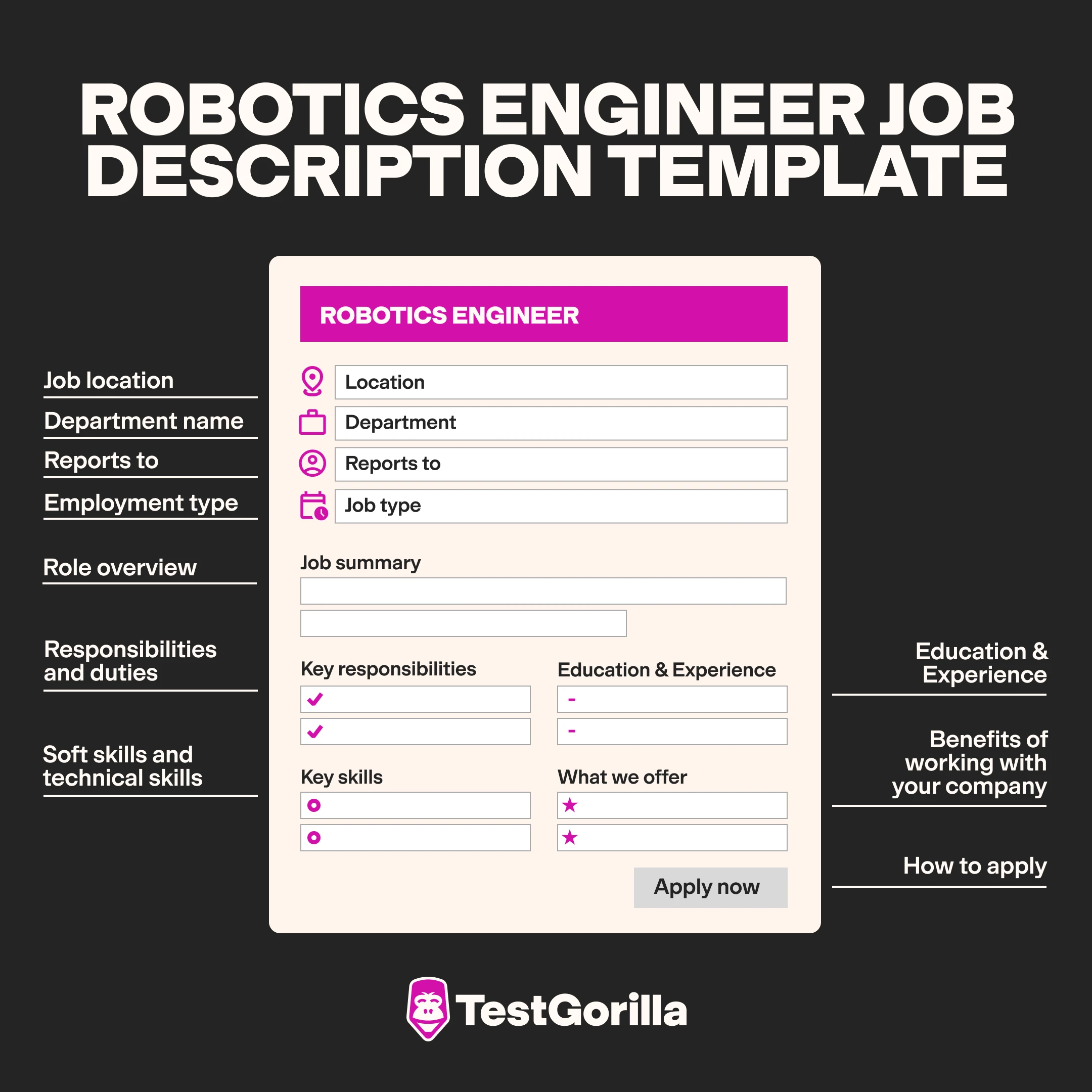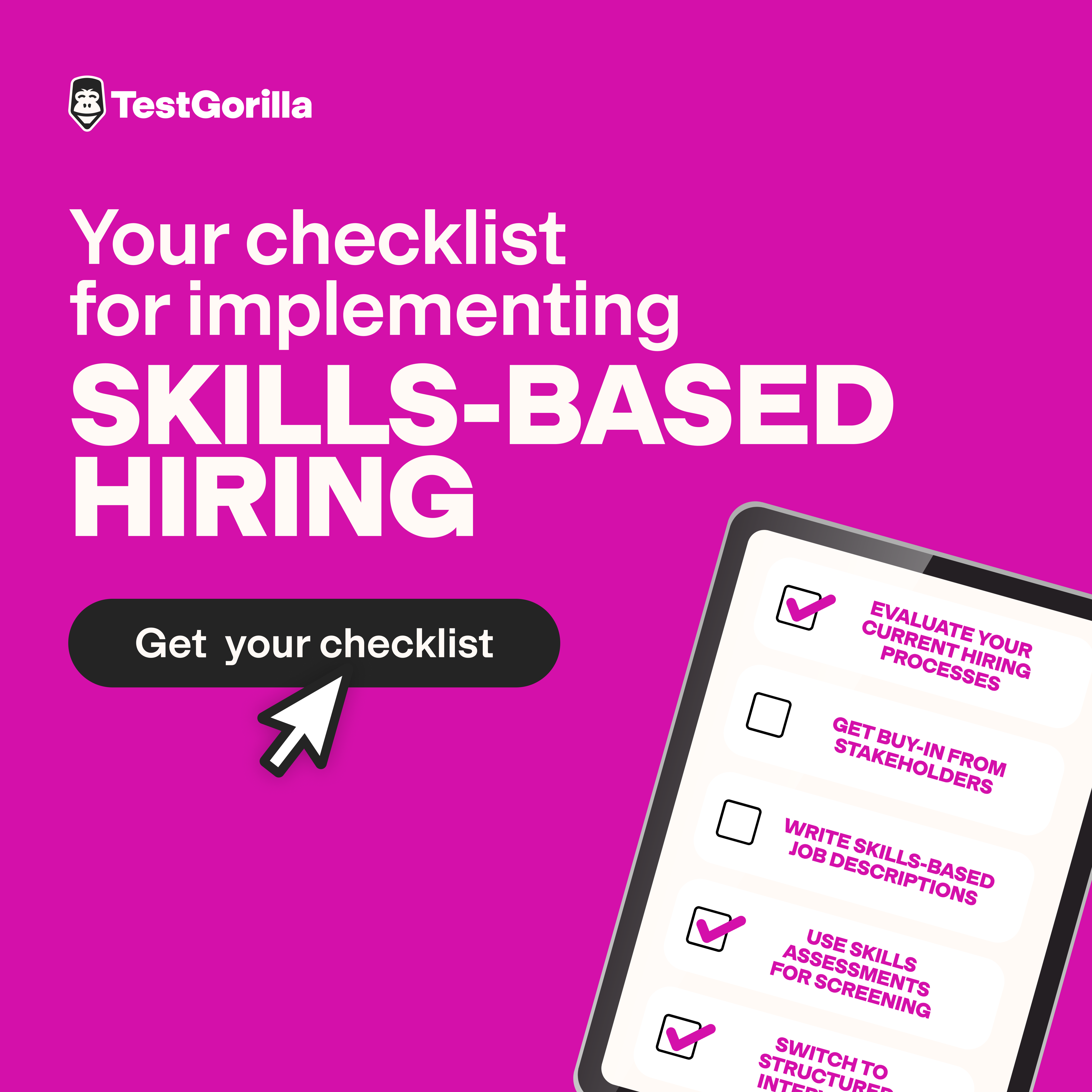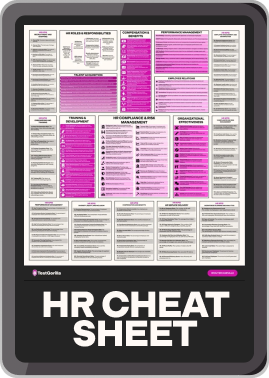Robotics engineer job description template: Everything you need to include
Hiring a robotics engineer can be challenging; they need a combination of technical skills, creativity, problem-solving, and the ability to collaborate within multidisciplinary teams. The first step to finding the best talent for your role is writing a solid job description – which can be quite a task in itself.
We’ve created this robotics engineer job description template so you can skip the guesswork and get a headstart on hiring.
While a well-crafted job description will be a beacon to the caliber of robotics engineers you’re searching for, it may also attract unsuitable applications. To cut through the noise and separate the qualified candidates from the unqualified ones, you need to take a skills-first approach. Read on to learn more.
Robotics engineer job description template
Job Title: Robotics Engineer
Location: [City, State/Remote]
Department: [Department Name]
Reports To: [Manager/Supervisor Title]
Job Type: [Full-Time/Part-Time/Contract]
Job Summary
About the Role
We are looking for a highly skilled Robotics Engineer to design, develop, and implement robotic systems that enhance automation, efficiency, and innovation. As a Robotics Engineer, you will work on cutting-edge projects, collaborating with multidisciplinary teams to create intelligent, adaptable, and scalable robotic solutions.
If you are passionate about robotics, problem-solving, and pushing technological boundaries, this is the perfect role for you!
Responsibilities
Design, develop, and test robotic systems, including mechanical structures, control algorithms, and embedded software.
Program, simulate, and optimize robotic movements using industry-standard tools (e.g., ROS, MATLAB, Python, C++).
Integrate AI and machine learning into robotics applications for automation and enhanced functionality.
Develop and implement control algorithms for motion planning, perception, and real-time decision-making.
Collaborate with electrical, mechanical, and software engineers to build robust robotic solutions.
Analyze performance, troubleshoot issues, and continuously improve robotic systems through testing and iteration.
Stay updated with industry advancements and apply innovative solutions to enhance robotic capabilities.
Requirements
Soft Skills & Work Approach:
Strong problem-solving and analytical skills.
Ability to collaborate effectively in multidisciplinary teams.
Excellent communication and documentation skills.
A growth mindset with a focus on learning and innovation.
Technical Skills:
Proficiency in robotic programming (Python, C++, MATLAB, ROS, or similar).
Hands-on experience with robotic hardware, actuators, sensors, and control systems.
Familiarity with AI, computer vision, or machine learning for robotic applications.
Knowledge of embedded systems and microcontrollers (Arduino, Raspberry Pi, etc.).
Understanding of robot kinematics, dynamics, and motion control.
Education & Experience:
Bachelor’s or Master’s degree in Robotics, Mechanical Engineering, Electrical Engineering, Computer Science, or a related field.
5+ years of experience in robotics engineering, automation, or mechatronics.
Why Join Us?
Skills-Based Hiring: We assess candidates based on skills, not just resumes.
Innovative Projects: Work on cutting-edge robotic solutions that make a real impact.
Inclusive Culture: We value diversity, transparency, and equal opportunities.
Career Growth: Continuous learning, mentorship, and professional development opportunities.
If you are a passionate Robotics Engineer looking for your next challenge, apply today and be part of our innovative journey!
Application Instructions
To apply, please submit your resume, cover letter, and portfolio (if applicable) to [email/website link].
Deadline: [Insert Application Deadline]
[Company Name] is an Equal Opportunity Employer. We celebrate diversity and are committed to creating an inclusive environment for all employees.
Why this robotics engineer job description template works
The specificity and structure of this template are designed to appeal to quality robotics engineering candidates from the get-go.
By detailing the Location, Department, Reports To, and Job Type, we immediately clarify key information about the role – is it working in a robotics R&D lab, on-site in a manufacturing plant, or remotely developing AI-driven control systems? This clarity helps prospective candidates quickly decide if your position matches their expertise, ensuring more relevant applications.
Next, we dive into the key aspects of the job. About the Role details whether candidates will be developing autonomous navigation systems for space exploration or maintaining and optimizing existing robotic assembly lines. This section also defines the type of engineer who will thrive in the position – again encouraging quality candidates to apply.
Breaking down Responsibilities into distinct duties gives potential applicants a clear understanding of their daily tasks. A detailed list, along with the specific tools they’ll use, further helps robotics engineers assess whether the role fits their expertise and increases your chances of getting highly qualified candidates.
Dividing Requirements into categories makes it easy for robotics engineers to quickly see if their skills and background match. We prioritize skills-first hiring by listing Soft Skills & Work Approach and Technical Skills before Education & Experience. This ensures candidates are assessed on what truly matters – their practical robotics engineering abilities. These hands-on, real-world skills and personal attributes are vital for success in a cutting-edge field like robotics engineering.
Why Join Us? This section provides an opportunity to gain an edge over competitors vying for the same top talent. Robotics engineers value innovation-driven, forward-thinking employers. Highlighting how your company and the specific position you’re hiring for align with these values will catch the attention of talented robotics engineers eager to contribute to groundbreaking projects.
Pro tip: Don’t forget to include detailed Application Instructions to ensure a straightforward and streamlined application process for your robotics engineering role.
The best insights on HR and recruitment, delivered to your inbox.
Biweekly updates. No spam. Unsubscribe any time.
Next steps: Attracting and assessing robotics engineer candidates
Once you’ve fine-tuned your robotics engineer job description, you can post it on job boards and start assessing candidates for the role.
The fastest, most accurate, and fairest way to do this is with talent assessments. TestGorilla's library of 400+ tests tap into job-specific skills, cognitive abilities, personality traits, and culture fit, making shortlisting candidates a breeze.
For a Robotics Engineer role, consider using:
Role-specific tests
Mechanical Reasoning test
Intermediate Math test
Spatial Reasoning test
Attention to Detail test
Soft skills and cognitive abilities
Problem Solving test
Critical Thinking test
Personality and culture
Culture Add test
You can combine up to five tests per assessment to match your hiring needs and include custom questions. Given the rapid advancements in robotics, taking a strategic approach like this is far more reliable than relying on degrees and employment history alone.
Get started with TestGorilla today by requesting a free live demo or signing up for a free account.
FAQs
What does a robotics engineer do?
Robotics engineers design, develop, and maintain robotic systems for a range of industries, including automation, manufacturing, and healthcare. Their work integrates software engineering and mechanical and electrical engineering to produce autonomous and semi-autonomous machines.
Which degree is best for robotics engineering?
In addition to a robotics engineering degree, qualifications in computer science, mechanical engineering, electrical engineering, and mechatronics are also highly relevant for a career in robotics.
Is robotics a lot of math?
Robotics involves a significant amount of math. Specifically key areas like basic arithmetic, linear algebra, calculus, probability, and statistics. Applying these mathematical concepts is essential for tasks like programming robotic movements, developing control algorithms, and optimizing system performance.
Related posts
You've scrolled this far
Why not try TestGorilla for free, and see what happens when you put skills first.















